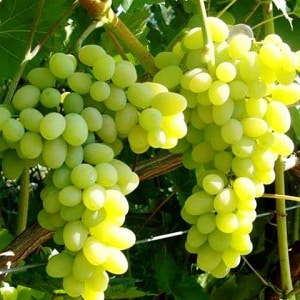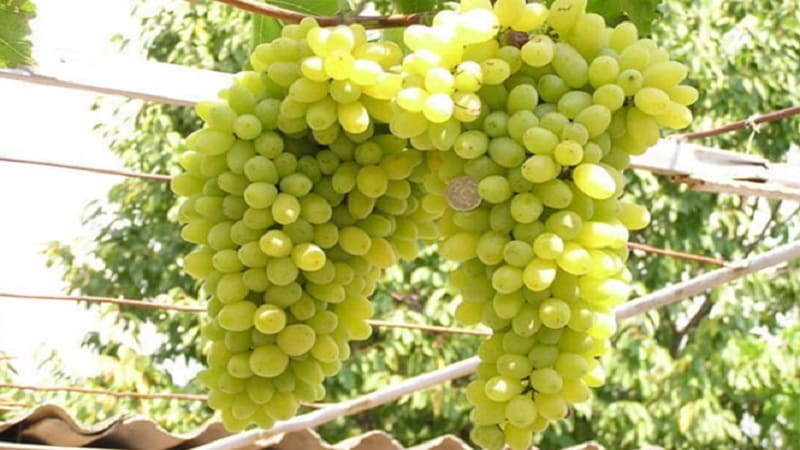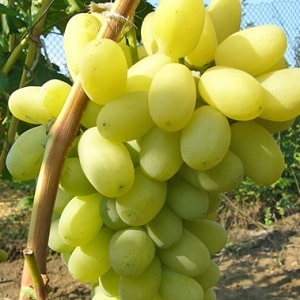Laura grape variety, one of the top most productive and delicious
The table grape variety Laura is grown in many regions of Russia. The plant is unpretentious to the place of growth and soil composition. The early ripening period allows you to enjoy juicy sweet berries with a nutmeg aftertaste already in mid-August.
Read about the features of growing grapes, methods of planting, pruning and disease control in our article.
History of origin and description of the Laura grape variety
Laura grapes are a table variety bred in Odessa “NIViV named after. V. E. Tairova" by crossing the varieties Muscat de Saint-Valier, Muscat Hamburg (a mixture of pollen) and Khusayne, Koroleva Tairovskaya and pollen of Central Asian grape varieties.
The variety has another official name - Flora, but among amateur winegrowers it is known as Laura. The popularity of the variety is due to the successful combination of parent pairs, early ripening, and the pleasant taste of the berries. The variety is widespread in Moldova, Ukraine and Russia.
Characteristics and description of the plant
Laura grapes ripen early - 110-115 days pass from the moment the eyes appear to full ripeness. The growth vigor of the bushes is above average.
The type of pollination is female, but there are no problems with pollination when planting varieties Kodryanka, Arcadia, and Kishmish radiant nearby. The leaves are five-lobed, dark green.
The vine ripens completely. The number of fruitful shoots is 60-80%. On average, 0.9-1.3 bunches ripen on each shoot.
Grape clusters are large, conical, 40-60 cm long, weighing 1 kg. The use of vigorous rootstocks allows you to obtain bunches weighing about 3 kg.
Brushes of medium density, moderately loose. Vigor and pollination influence cluster density.
The plant begins to bear fruit 3 years after planting. cuttings. The berries are cylindrical or oval, weighing 10-12 g.
The color is white-green, the skin is covered with a waxy coating. On the sunny side, the berries are covered with a light amber tan. The berries remain on the bunches for a long time, do not fall off or crack. The yield is 40 kg per bush.
The pulp is crispy, dense, with a nutmeg flavor. Contains large seeds inside. The taste is pleasant and balanced. Sugar content - 20-22%, acidity - 5-8 g/l. Tasting taste score: 8.4 points.
The Laura variety is resistant to frosts down to -23 °C, and is not prone to gray and white rot and mildew. Grapes do not have immunity to fungi that cause oidium, and therefore require preventive treatments.
The photo shows Laura grapes.

Advantages and disadvantages
Advantages of the Laura variety:
- high productivity;
- early ripeness;
- pleasant, balanced taste;
- large berries that are not prone to cracking;
- frost resistance;
- unpretentiousness to the place growing;
- possibility of transportation over long distances;
- resistance to major fungal diseases.
Flaws:
- the need to normalize the brushes to reduce the load on the bush and improve the taste of the berries;
- changes in sugar content and acidity depending on climate and soil fertility.
Growing technology
Laura grapes can be grown in almost any type of soil. Clay soils and high salt content are preferable. It is important to avoid areas with high groundwater levels, and give preference to sunny places, without drafts, gusty winds and shading.
The variety is propagated by cuttings, which are harvested in the fall. Planting is carried out with prepared seedlings and rootstock. Grafting makes it possible to get a harvest earlier; the cutting receives more nutrients from the old bush. However, the seedling planting method is more popular due to its simplicity and efficiency.
Preparation of cuttings
Ready-made seedlings are purchased from winegrowers or specialized nurseries, but if desired, you can prepare them yourself.
Rules for preparing cuttings:
- Cuttings are harvested after the bushes have completely shed their leaves, before the onset of frost.
- The vine is inspected for damage and disease. It should crack when bent. The color should be uniform, brown, without inclusions, the core should be dense, not loose.
- Cuttings are cut from branches that have ripened this year, from the middle part of the vine. They should have 4-6 developed buds. The optimal length is 50–70 cm, diameter 5-7 mm.
Storage rules:
- The tendrils and leaves are completely removed, the cuttings are soaked in warm boiled or melt water for 24 hours.
- After soaking, the cuttings are disinfected in a pink solution of potassium permanganate or copper sulfate (1 tsp per 250 ml of boiling water). Then they are dried in the open air and placed in a tight plastic bag or plastic bottle.
- The cuttings are placed on the middle shelf of the refrigerator and stored at a temperature of 0...+4°C until spring.
- The preparations are checked once a month. If mold appears on them, wash them in a dark solution of potassium permanganate or wipe with a cloth soaked in a solution of copper sulfate (1 tsp per 250 ml).
At the beginning of spring, the cuttings are checked for viability - a cut is made at the ends. If moisture appears, it means they are ready for planting; if not, they are dry. If liquid oozes from the cuttings, this indicates that they have rotted. The cut should be light green. Dark spots indicate infection.
Shallow furrows are made on each viable cutting, from the middle to the end, and immersed in clean water at room temperature. It is changed 3-4 times within 24 hours. The cuttings are soaked for 48 hours.
After soaking, they are immersed in the root formation stimulator “Kornevin” or “Heteroauxin” for 30 minutes and placed in a container with wet sawdust. The cuttings are left in a warm place for 10-15 days. After the roots appear, the cuttings are placed in a bottle of water and await the development of a full-fledged root system.
Landing
Landing rules:
- Planted in mid-May, when the air warms up to at least +17 °C.
- Holes measuring 80x80 cm are dug on the site, with an interval of 1.5 m.
- Broken brick or small crushed stone is placed at the bottom in a layer of 10 cm.
- Fertile soil mixed with 1 kg of humus, 200 g of superphosphate, 1 liter of wood ash is poured on top and watered with settled water.
- A pipe for irrigation is dug in the center of the hole. Then add a layer of clean soil without fertilizers so that half a meter remains to the edges, and place the cutting.
- The rhizome is carefully straightened, the hole is filled to the brim with fertile soil and watered.
Further care
Laura grapes are watered twice: during the period of bud swelling and at the end of flowering. During the initial flowering period, do not water due to the risk of flowers falling off..
Watering is done in the evening. Water consumption - 50 l/m2. On sandy or sandy loam soil, the flow rate is increased to 75 l/m2.Water is poured into the furrows in case of row planting or into circular holes, maintaining a distance of 70 cm. Then the soil is loosened to ensure the flow of oxygen to the roots.
Fertilizing begins to be applied during the period of swelling of the buds. Two holes 0.4 m deep are dug along the inner edges of the hole, and 0.5 liters of nutrient mixture are added: 1 part chicken manure, 2 parts water diluted in 20 liters of water.
The second fertilizing is applied simultaneously with the second watering: 20 g of superphosphate, 10 g of ammonium nitrate, 10 g of potassium salt per 10 liters of water.
For Laura grapes, foliar feeding is useful:
- 3 weeks before flowering (approximately late May-early June), the bushes are sprayed with a nutrient solution: 5 g of boric acid, 4 g of sodium humate per 10 liters of water.
- The second foliar feeding is carried out 14 days after flowering: 5 g of boric acid, 4 g of sodium humate, 20 g of potassium magnesium per 10 liters of water.
- The third foliar feeding is carried out at the beginning of grape ripening: 40 g of superphosphate, 20 g of potassium sulfate per 10 liters of water.
Bush pruning carried out in the spring. The most universal option is fanless pruning, suitable for any growing region.
The table shows a typical scheme.
| Grape age | 2 years | 3 years | 4 years | 5 years or more |
| Procedures | Two viable shoots are selected and cut into three eyes. As they grow, they are tied symmetrically in different directions.
|
Of the four shoots, two extra ones will be removed, the remaining ones will be used to create sleeves. They are cut to 40-60 cm, measuring from the ends, and tied to the trellis at an angle of 45°. All shoots, except the top ones, are cut off.
|
Fruit links are formed at the end of each sleeve. The lower vine is cut into a branch, the upper vine is cut into 5-10 buds and tied horizontally.
|
The old vine is cut off, leaving 2 cm of stump.Carry out sanitary pruning and remove weak, dry and crooked shoots. The bushes are thinned out, preventing thickening. |
The bunches are rationed in the spring. If the bushes are young, wait until the brushes form and select the best ones, removing the rest. Adult bushes are rationed during the flowering period. This way the plant will not waste energy on developing weak ovaries.
Laura grapes form 35-45 clusters on one bush, but you need to leave 23-25 clusters. Experienced winegrowers advise leaving 1 cluster on one vine. If the weight of the bunch exceeds 1.5 kg, all clusters are completely removed from every third shoot.
For full development, the grapes are tied to a trellis. To install it, you will need 2 pillars of 2.5 m each, with a diameter of 10 cm. They are dug in at intervals of 3 m to a depth of 70 cm. Galvanized steel wire with a diameter of 2.5 mm is pulled between them in 3 rows. The first row is placed at a height of 40 cm from the ground surface, the second - 40 cm, the third - 50 cm after the second.
Possible problems, diseases, pests

The Laura grape variety is resistant to mildew (3 points), gray and white rot. The main problem of the plant is oidium or powdery mildew. To prevent infection, bushes are treated with a sulfur solution (25-40 g per 10 liters of water), a dark solution of potassium permanganate, and Ridomil. For treatment, a sulfur solution is used, but take 100 g per 10 liters of water. Treatments are carried out in the evening or in cloudy weather 3–5 times, every 10 days.
Sulfur is used at air temperatures above +20°C. At lower temperatures, Storby, Cumulus DF, Switch, and colloidal sulfur are used.
Grapes are often affected by grape budworms, grape mites and aphids. To destroy ticks, insecticides are used: “Fufanon”, “Neoron”, “Aktellik”.The drugs Fozalon and Sumicidin are effective against leaf rollers. Fozalon and Kinmiks will help destroy aphids.
Wintering
Preparing grapes for wintering begins in late September - early October. Two weeks before shelters The bushes are watered abundantly. Water consumption - 20 liters per bush. Leaves and unripe vines are cut off. The shoots are removed from the trellises, folded into a bundle and tied with twine.
It is recommended to additionally treat the bushes with a solution of copper sulfate (100 g per 1 liter of boiling water, diluted in 9 liters of water).
Covering methods:
- Trench. This method allows you to cover the roots. The depth of the trench is 20–30 cm. The walls are reinforced with boards or slate. The tied vine is placed in a recess, earth is poured on top, 40 cm high.
- Greenhouse. The method is suitable for shelter for several bushes. The bundles are laid on the ground. Arcs are installed along them and the film is stretched. The bushes are covered with sawdust or spruce branches. It is important to leave some air to prevent the grapes from rotting.
- Hut. The grape bunches are laid on the ground, covered with burlap, straw or sawdust. Sheets of slate are installed on top in the form of a house, and reinforced with bricks or embankment.
- earth embankment. The bunches are laid on the ground, covered with burlap, straw, dry leaves, sawdust, and covered with a layer of soil up to 30 cm.
Important! In the southern regions, the shelter is removed in mid-April, in the central and northern regions - in the first ten days of May.
Harvesting and application
Harvesting in the southern regions is carried out in mid-August, in the central and northern regions - 2 weeks later. The bunches are placed in wooden boxes and stored for about three months in the cellar at a temperature of +2...+4 °C.
The berries are suitable for fresh consumption, making compotes, jam and white wine.
Features of growing varieties depending on the region
Laura grapes grow and bear fruit in the Urals, Siberia, and the Moscow region, provided they are planted along walls or fences when the air temperature rises to +17 °C. In the south of the country, grapes are planted in any suitable place in the fall.
The grapes are unpretentious and can withstand cold, but show best results when grown in warm climates.
Reference. Grapes need abundant watering in the south. In temperate climates, seasonal rains are sufficient for the plant.
Reviews from winegrowers
Winegrowers leave mostly positive reviews about the Laura grape variety.
Valery, Chekhov: “I like the Laura variety for its ease of care and frost resistance. In our region, bushes require shelter. For myself, I found the best way to preserve the vine - shelter in a trench. The rhizome does not freeze under a layer of soil and snow. The berries sometimes do not reach the size presented in the description of the variety, this happens when there is a lack of sun and nutrition. Increasing soil fertility and thinning bushes solves the problem.”
Irina, Borisoglebsk: “Laura is one of my favorite grape varieties. We planted it from cuttings 5 years ago. In our climate it bears fruit abundantly and does not require special care. We carry out sanitary pruning, feed with organic matter and minerals. One summer turned out to be particularly rainy, and the bushes became sick with powdery mildew, even with preventative treatment in the spring. They were saved with a sulfur solution. The berries are oblong, sweet, very tasty. We make wine from them, close the compotes.”
Conclusion
Growing the cultivated grape variety Laura does not require much labor.The plant needs moderate watering before and after flowering, and before wintering, the addition of organic-mineral complexes, preventive spraying against oidium, gartering, pruning and rationing of bunches.
A universal table variety suitable for fresh consumption and processing into compote and wine. The taste of the berries is balanced, with a nutmeg aftertaste. The clusters are large, conical in shape, weighing 1-3 kg.